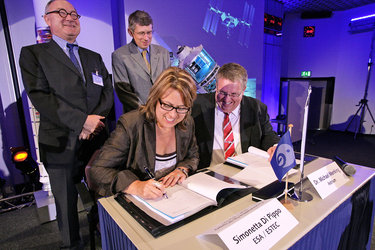ATV evolution: Advanced Reentry Vehicle (ARV)
The very successful Jules Verne ATV mission has highlighted many new technologies and capabilities that can be used and adapted in the future for developing new spacecraft, making use of additional European know-how, such as atmospheric reentry technologies. Such development could be of great strategic importance for Europe’s role in human spaceflight endeavours in low-Earth orbit and for future exploration missions, leading to an autonomous launch and return capabilities to and from orbit.
Autonomous access
The ATV currently has a capability to re-supply the ISS with up to 6.6 tonnes of propellants and cargo, and is the largest orbiting space vehicle beside the US Space Shuttle. With the Space Shuttle retirement planned in 2010, the ISS partners will lose a major capability to return heavy equipment to Earth for replacement or upgrade. Following on from previous studies, the next logical step will be the capability to return payloads and goods from the ISS and any future orbital infrastructure.
Cargo re-entry capsule

In this scenario the pressurised front cargo section of the ATV (the Integrated Cargo Carrier) would be replaced by a cargo re-entry capsule equipped with a heat shield and able to bring back hundreds of kg of cargo and valuable experiments. Such a project could use the heritage of the Atmospheric Re-entry Demonstrator, which flew successfully in 1998, as well as the work carried out in the period 1998-2002 on the Crew Return Vehicle for the ISS and associated technologies.
This system will use an updated service module, propulsion system, and similar rendezvous and docking technology as the present ATV. The development of a new cargo transportation and reentry capsule would complete the new vehicle. This spacecraft could be operational by 2015 and as such could provide a valuable service to the International Space Station in payload upload and download. The spacecraft would use the Ariane 5 ES launch vehicle for such missions with a modified fairing.
Future developments: Crew Transportation
Once the capability of bringing back cargo from space has been demonstrated, such a spacecraft could undertake the next logical step: a European crew transportation system, which would require more complex modifications and additional technologies.
The service module would require further upgrades including an improved propulsion system and the addition of the subsystems supporting the crew presence and operations. The upper part of the Advanced Reentry Vehicle would be transformed into a human rated re-entry capsule. The new transportation system could be launched on a suitably modified version of Ariane 5.
This second-step vehicle would require additional developments in flight safety, especially for a guided crew escape system during launch and life support subsystems. This crew escape system would consist of solid rocket motors able to pull the crew capsule away from the launcher in the event of an emergency. It would have the capability to accommodate four astronauts and could be operational by 2020.
For both the manned and unmanned versions of the Advance Reentry Vehicle, the most likely scenario is that the return module would ditch in water, probably in the Atlantic Ocean off the European coast.
The principle of this spacecraft could be used in support to future orbital infrastructures, and could be the basis for successive modifications in support to future exploration missions.
In 2024, ESA signed two contracts with European industry to develop a commercial service capable of transporting cargo to and from the International Space Station in low Earth orbit by 2030. Find out more.




